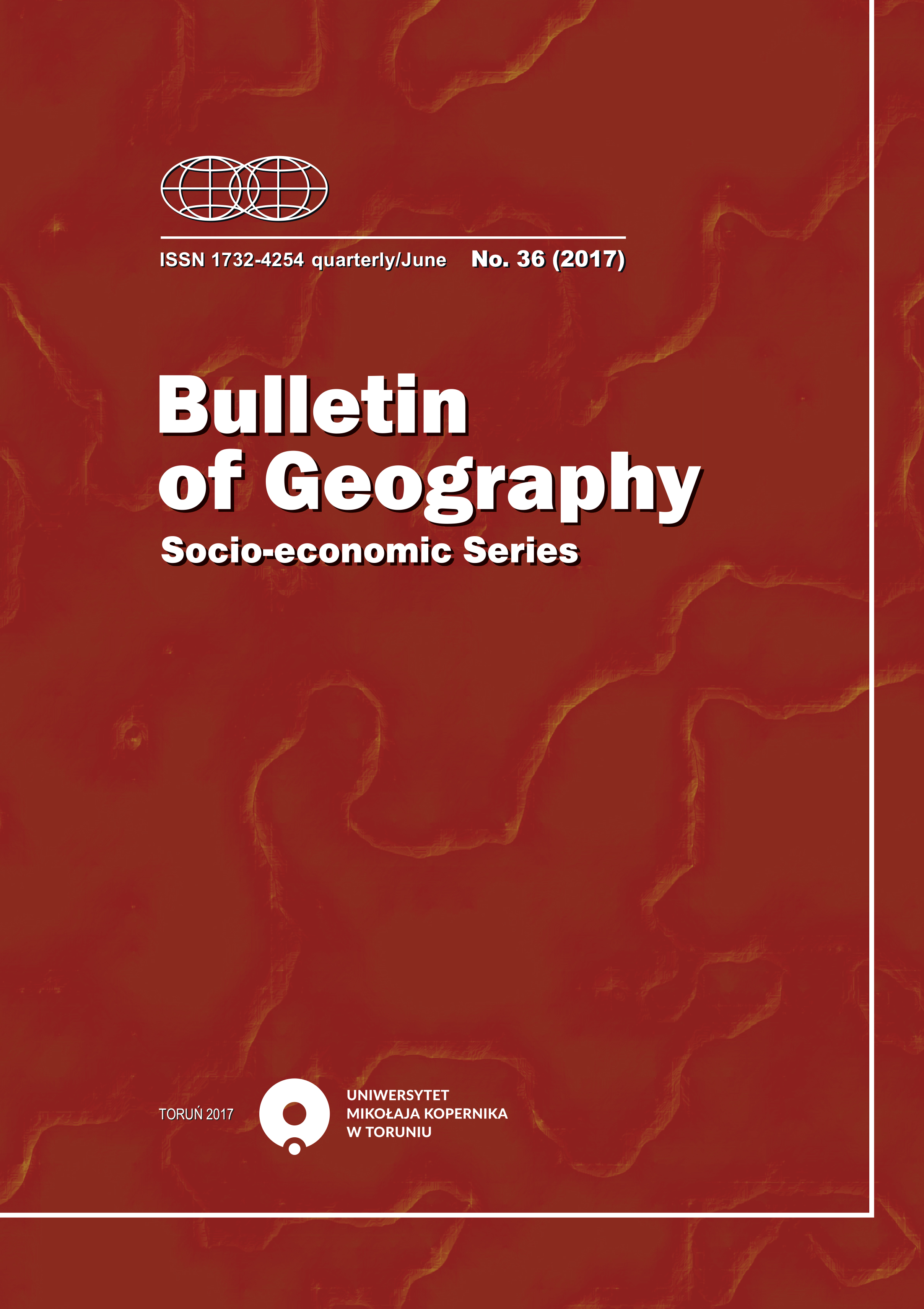Analysis of the Re-emergence and Occurrence of Cholera in Lagos State, Nigeria
DOI:
https://doi.org/10.1515/bog-2017-0012Abstract
This paper analysed the factors responsible for the re-emergence of cholera and predicted the future occurrence of Cholera in Lagos State, Nigeria using factor analysis, multiple linear regression analysis and a cellular automata model for the prediction. The study revealed six Local Government Areas (LGAs) under very high threat, nine under low threat, and Surulere and some parts of Amuwo Odofin under medium threat in the near future. These areas have an average population of 200,000 people each with the total tending towards millions of people, all under threat of cholera occurring and re-emerging in their communities. The factors relating to the re-emergence of the disease were discovered to be environmental (rainfall, R2=0.017, P<0.05 and temperature, R2=0.525, P>0.05); socio-economic (household size R2=0.816, P>0.05; income, R2=0.880, P>0.05; and education, R2=0.827, P>0.05). The Cellular Automata Markov Prediction model showed that by 2016, Lagos State will experience 79 cholera cases which will increase to 143 in 2020. This prediction model revealed that Ikorodu will record 40 cases, Apapa 12, Ojo 5, Mushin 3, while Amuwo-Odofin, Badagry and Ajeromi-Ifelodun LGAs will each record 2 cases between 2011 and 2016. The study concludes that there is a cholera threat in Lagos State and the factors of vulnerability that predispose people to the disease must be tackled over time and space for effective prevention, control and management of the disease .References
Adagbada, A.O., Adesida, S.A., Nwaokorie, F.O., Niemogha, M.T. and Coker, A.O., 2012: Cholera Epidemiology in Nigeria: An overview. In: The Pan African Medical Journal, Vol. 12, pp. 1-12. ISSN 1937-8688.
Comrey, A.L. and Lee, H.B., 1992: A first course in Factor Analysis, Hillsdale: NJ: Eribaum. DOI: 10.1177/0092070394221002
Fu, S.Ch. and Milne, G., 2003: Epidemic Modelling Using Cellular Automata: The First Australian Conference on Artificial Life; Canberra, Australia. DOI: 10.1016/j.neucom.2014.08.036
Hutin, Y., Luby, S. and Paquet, C., 2003: A large cholera outbreak in Kano City, Nigeria: the importance of hand washing with soap and the danger of street-vended water. In: Journal of Water and Health. Vol. 1, pp. 45-52. PMID: 15384272.
Kistemann, T., Dangendorf, F. and Schweikart, J., 2002: New perspectives on the use of Geographical Information Systems (GIS) in environmental health sciences. In: International Journal of Hygiene and Environmental Health. Vol. 3, pp. 169-181. DOI: http://dx.doi.org/10.1078/1438-4639-00145
Lagos State Government: Lagos State, available at http://www.lagosstate.gov.ng. DoA: 15 December, 2012.
Lobitz, B., Beck, L., Huq, A., Woods, B., Fuchs, G., Faruque, A.S.G. and Colwell, R., 2000: Climate and infectious disease: use of remote sensing for detection of Vibrio cholerae by indirect measurement. In: Proceedings of the National Academy Sciences of the United States of the America, 15 February 2000, Vol. 97 (4), pp. 1438-1443. DOI: 10.1073/pnas.97.4.1438
May, J.M., 1958: The Ecology of Human Disease. New York: M.D. Publications.
Meade, M.S. and Earickson, R.J., 2001: Medical Geography. New York: Guilford Press, p. 698.
Mintz, E.D. and Guerrant, R.L., 2009: A lion in our village, the unconscionable tragedy of cholera in Africa. In: The New England Journal of Medicine Vol. 360, pp. 1060. DOI: 10.1056/NEJMp0810559
NPC, National Population Commission 2006 Census.
Petit, G., Carrefour, C. and Leogane, V., 2010: Cholera outbreak: Note on community beliefs, feelings and perceptions. Haitian Red Cross psychological support programme.
Rogers, D.J. and Randolph, S.E., 2003: Studying the global distribution of infectious diseases using GIS and RS. In: Nature Reviews: Microbiology, Vol. 1, pp. 231-237. DOI: 10.1038/nrmicro776
Sack, D.A., Sack, R.B., Nair, G.B. and Siddique, A.K., 2004: Cholera. In: The Lancet, Vol. 363. January 17, 2004, available at: www.thelancet.com. DOI: http://dx.doi.org/10.1016/S0140-6736(03)15328-7
Snow S.J., 2002: Commentary: Sutherland, Snow and water: the transmission of cholera in the nineteenth century. In: International Journal of Epidemiology. Vol. 31, pp. 908–911. DOI: 10.1093/ije/31.5.908
Swerdlow, D.L. and Isaacson, M., 1994: The epidemiology of cholera in Africa. In: Wachsmuth, K., Blake P. and Olsvik O. editors, Vibrio cholerae and cholera: Molecular to global perspectives. Journal of Water and Health, Vol.1. Washington: American Society for Microbiology, DC.
Tabachnick, B.G. and Fidell, L.S., 1996: Using Multivariate Statistics (3rd ed.). New York: Harper Collins.
Twigg L., 1990: Health Based Geographical Information Systems: their potential examined in the light of existing data sources. In: Social Science and Medicine, 30(1), pp. 143-55. PMID: 2305277. DOI: http://dx.doi.org/10.1016/0277-9536 (90)90337-R
United Nations Children’s Fund (UNICEF), 2007: The state of the World Report. New York: UNICEF.
Washino, R.K. and Wood, B.L., 1994: Application of remote sensing to arthropod vector surveillance and control. In: American Journal of Tropical Medicine and Hygiene, Vol. 50, pp.134–144. (PMID:8024079).
World Health Organization - Cholera, What is Cholera? Centres for Disease Control and Prevention. WHO.
World Health Organization (WHO), 2003: World Health Report 2003—Shaping the Future. Geneva: World Health Organization.
World Health Organization, 1996: World Health Report 1996-Fighting Disease. Geneva: World Health Organization.
World Health Organization, 2012: Statistical Information System. Geneva: WHO (2012), available at: http://www.who.int/whosis/data/ DOA: 18 January, 2015.
Xu, B., Gong, P., Biging, G., Liang, S. and Seto, E., 2004: Snail density prediction for schistosomiasis control using IKONOS and ASTER images. In: Photogrammetric Engineering and Remote Sensing, Vol. 70(11), pp. 1285-1294. DOI: 10.14358/PERS.70.11.1285
Xu, B., Gong, P., Seto, E., Liang, S. and Yang C.H., 2006: A spatial temporal model for assessing the effects of inter-village connectivity in schistosomiasis transmission. In: Annals of the Association of American Geographers, Vol. 96, pp. 31-46. DOI: 10.1111/j.1467-8306.2006.00497
Zhen, J. and Quan-Xing, L., 2006: A cellular automata model of epidemics of a heterogeneous susceptibility. In: Chinese Physics. Vol. 15, pp. 1248-1256. DOI: http://dx.doi.org/10.1088/1009-1963/15/6/019
Downloads
Published
How to Cite
Issue
Section
License
Title, logo and layout of journal Bulletin of Geography. Socio-economic Series are reserved trademarks of Bulletin of Geography. Socio-economic Series.Stats
Number of views and downloads: 628
Number of citations: 5



